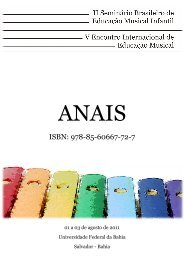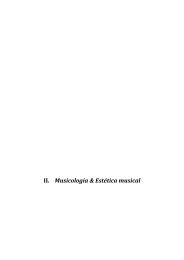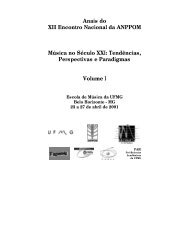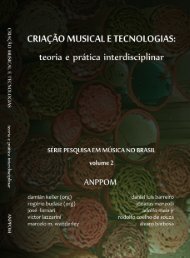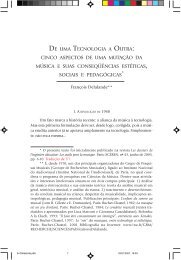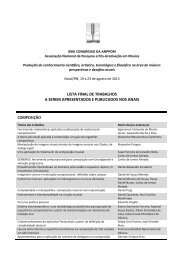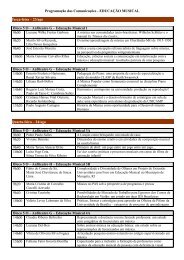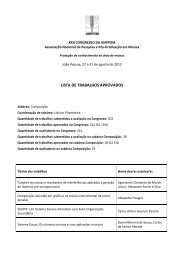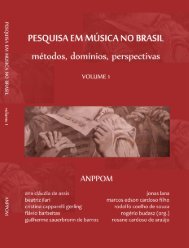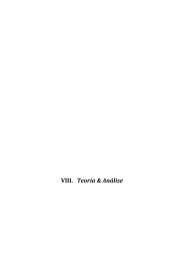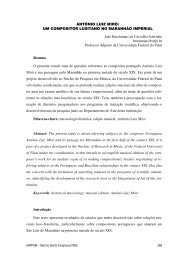download da versão impressa completa em pdf - anppom
download da versão impressa completa em pdf - anppom
download da versão impressa completa em pdf - anppom
Create successful ePaper yourself
Turn your PDF publications into a flip-book with our unique Google optimized e-Paper software.
. . . . . . . . . . . . . . . . . . . . . . . . . . . . . . . . . . . . . . . . . . . . . . . . . . . . . . . . FORNARI; SHELLARD; MANZOLLI<br />
methodology here used to generate the sound output of this musical application.<br />
Cont<strong>em</strong>porary Generative Art<br />
Generative Art are broadly defined as rule-based artwork syst<strong>em</strong>s, which are “set<br />
into motion with some degree of autonomy” (GALENTER, 2003). Algorithmic and<br />
Generative processes had already been extensively explored in arts and music composition.<br />
Athanasius Kircher – believing that musical harmony should reflect universal proportions –<br />
wrote in the 1650’s the book entitled: Musurgia Universalis, where he described the design of<br />
a music generating machine (CRAMER, 2005). In 1793, Hummel published a syst<strong>em</strong> to<br />
generate musical notation, whose creation was attributed to Mozart, in which music scores<br />
were ass<strong>em</strong>bled by predefined bars, chosen through a dice tossing game. Mozart’s syst<strong>em</strong><br />
<strong>em</strong>beds most of generative cont<strong>em</strong>porary methodologies in which musicians might create –<br />
throughout simple rules and building blocks (i.e. the predefined musical bars) – an<br />
astonishing amount of new compositions. Later, this algorithm was known as the Mozart's<br />
dice game and influenced many composers, such as John Cage and Lejaren Hiller, in the<br />
creation of their musical piece entitled HPSCHD (HUSARIK, 1983).<br />
The main proposition of Generative Art is to release the artwork from the artist's<br />
total control, thus letting it, as an independent entity, free to explore subtle variations<br />
through reiterative generative processes. Reiteration and loosening of control where well<br />
explored during the 1960's, by musicians, visual artists and <strong>da</strong>ncers, sometimes also<br />
exploring partnerships with scientists and engineers. In 1968, Billy Kluver, John Cage and<br />
Robert Rauschenberg organized the Project 9 Evenings, where artists from different fields and<br />
engineers from the Bell Laboratories worked together on developing human-machine<br />
interactions, during 9 evenings of artistic performances. Some of the choreographies<br />
created were mainly based on simple repetitive tasks that interacted humans and machines<br />
(programmable electronic devices). This project resulted in the development of new<br />
technologies and artistic approaches over new tools and led the engineers Billy Kluver and<br />
Fred Waldhauer, with the artists Robert Rauschenberg and Robert Whitman to create the<br />
E.A.T. (Experiments in Art and Technology), a non-profit organization that gathered<br />
researchers and artists to work together, developing art and technology.<br />
An artwork autonomously created by a generative process is not restricted within<br />
any specific field, but in a multitude of different areas of knowledge, even beyond visual arts<br />
and music. A<strong>da</strong>ptive methods, such as Artificial Intelligence, Neural Networks and<br />
Evolutionary Computation, are recent areas of interfacing Science and Art. This fruitful<br />
opus . . . . . . . . . . . . . . . . . . . . . . . . . . . . . . . . . . . . . . . . . . . . . . . . . . . . . . . . . . . . . . . . . . . . . . . . . . . . . 135



